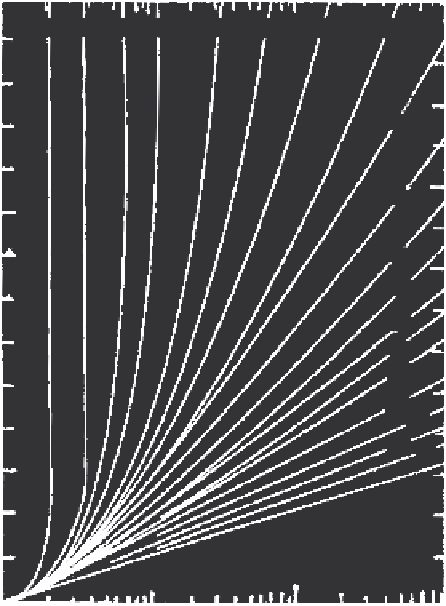Geoscience Reference
In-Depth Information
28
2
1.4
1.2
1.1
1.0
0.95
0.9
0.85
24
0.8
20
0.75
0.7
16
0.65
0.6
12
0.55
0.5
0.4
0.3
8
0.2
0.1
4
0
1
2
5 0
100
1000
(Y
1
- mX
2
)/(Y
2
- mX
2
)
FIGURE 16.9
Coburn diagram. (From USEPA,
APTI Course 415: Control of Gaseous Emissions
, EPA
450/2-81-005, U.S. Environmental Protection Agency Air Pollution Training Institute, Washington, DC, 1981,
p. 4 -30.)
The number of transfer units depends only on the inlet and outlet concentration of the solute
(contaminant or pollutant). For example, if the conditions in Equation 16.12 are met, 2.3 transfer
units are required to achieve 90% removal of any pollutant. Equation 16.12 only applies when the
equilibrium line is straight (low concentrations) and the slope approaches zero (very soluble or reac-
tive gases). Example 16.4 illustrates a procedure to calculate the packed tower height.
■
EXAMPLE 16.4. TOWER HEIGHT
Problem
: From pilot plant studies of the absorption system in Example 16.2, it was determined that
the
H
OG
for the SO
2
-water system is 0.829 (2.72 ft). Calculate the total height of packing required to
achieve 90% removal. The following data were taken from the previous examples.
Given:
H
OG
= 0.829 m
m
= 42.7 kg-mol H2O/kg mole air
G
m
= 3.5 kg-mol/min
L
m
= (3672 kg/min)(kg-mol/18 kg) = 204 kg-mol/min
X
2
= 0 (no recirculated liquid)
Y
1
= 0.03
Y
2
= 0.003

Search WWH ::

Custom Search